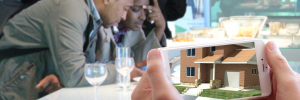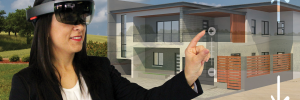Real Estate And Augmented Reality: The Future Is Now!
Pokemon Go was the biggest example of advanced technology phenomenon we have seen to date. Back in 2016, when it hit our relevant mobile app stores the game was downloaded and played by around 45 million daily active users. This was within 2 months of the game being released to the market. Due to its success, it has slowly been integrated into industries such as healthcare, business and more interestingly, real estate.
Before we look into the examples of augmented reality in real estate, let’s have a look at what augmented reality is.
What Is Augmented Reality?
Augmented reality essentially combines the virtual world with the real world. It allows users to interact with both using computer-generated graphics, text and sounds laid upon the users’ real-life surroundings. How users interact with the graphics tends to be through mobile devices that are available on-the-go such as smartphones and tablets. Other forms of technology have been developed as a result of AR such as headsets like Microsoft HoloLens.
You may have also heard about virtual reality and trying to understand how the two differ. Augmented reality overlays digital elements on top of a real word environment, whereas virtual reality creates a full transformed digital environment that a user can immerse themselves in.
What Are The Examples Of Augmented Reality in Real Estate?
Although the real estate industry is still getting to grips with the introduction of augmented reality, there have been examples of apps that have helped to grow the use of technology in the industry. These have been introduced to benefit marketing as well as improve design and styling. So, what are the examples that we have:
Realar Places
Australian developed, Realar allows users to place 3D models within their vicinity, for example, in a large field or a nearby deserted area, and walk through the models as if it were their own house that’s in the process of being built. It was developed back in December 2017 and has been seen as a real breakthrough for real estate agents. This is because it allows them to showcase the potential of living spaces and provided buyers with a better understanding of what it would be like to live in the area, potentially increasing conversion rates.
A similar development for this type of technology is our very own HomeAR app. Next Reality’s HomeAR app renders life-size 3D models of houses/apartments to provide 360 degrees views. It enables you to walk in the house and also interact with the model to understand how it would function. It can be a great benefit for companies, real estate and landlords.
Commercial Real Estate AR
Commercial Real Estate AR is an app that can help users to scan commercial properties within their area that are on sale and immediately have access to the listing and information regarding the property. Information can include property diameters, available office space and how many occupants are currently in the commercial space. Communication services are also integrated within the app if the user wishes to contact the estate agent directly. It’s a technology that’s also looking to be pushed within the residential property as more and more residential conveyancing solicitors see benefits of what the app has.
IKEA Place
Have you ever gone into an IKEA store and been unsure about what a product would look like in your own living room or bedroom? IKEA developed an app back in 2017 which allows users to virtually decorate their own living space with IKEA products in their catalogue. All items shown in the app are full-scale which means users can understand exactly how it would fit in their own room.
You could say that augmented reality is still in its development stage as it continues to grow as a technology. However, it’s estimated that within 5 years augmented reality could generate $90 billion in revenue and there’s still potential for it to be defined and perfected making its possibilities endless. It’s likely to become the norm in several industries. Retail has benefitted greatly from apps such as 4DPaper as well as healthcare who have utilized the technology for teaching. From the examples shown above, real estate is also looking to benefit from the technology’s possibilities. What’s to come is yet to be seen, but what we’ve seen so far is already impressive.
Special thanks to our guest author!
 Author: Paul Matthews
Author: Paul Matthews
Paul Matthews is a Manchester based business writer who writes in order to better inform business owners on how to run a successful business. You can usually find him at the local library or browsing Forbes’ latest pieces.



